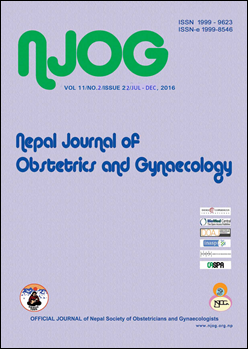Air Transfer of Obstetric Emergencies to a Tertiary Care Center in Nepal
Keywords:
airlift, obstetric emergenciesAbstract
Aims: This study was performed to review the places, indications, maternal-perinatal outcomes requiring emergency air transfer to a tertiary level referral center.
Methods: A hospital based descriptive study of one year duration, conducted in Tribhuvan University Teaching Hospital (TUTH), over a period of twelve months. All the women who were air transferred for pregnancy complications were enrolled.
Results: There were total 19 airlifted obstetric emergencies to TUTH over one year period: majority (68%) from hilly areas and others (32%) from mountain region. Out of them, referred cases were 11 [district hospital (5), healthpost (4); Primary Health Center (PHC) (2)]; and rest were from home (8). Two cases were abortion related; septic abortion (1) and incomplete abortion (1). There were three antepartum cases: pregnancy with meningoencephalitis (1), eclampsia (1) and bleeding placenta previa (1); maximum, eleven intrapartum cases, obstructed labor (6),labor dystocia (3), breech in labor (1) and undelivered second twin (1). Rest three were postpartum cases, one each of eclampsia, puerperal sepsis and retained placenta. Maternal morbidities were one each case of uterine rupture, acute kidney injury, retained placenta with PPH and vesicovaginal fistula that developed in the case of shoulder dystocia. Maternal mortality occurred in 2 cases, first women with antepartum eclampsia who had intracerebral bleed and second was a case of pregnancy with meningoencephalitis who later developed brain death. Regarding perinatal outcome 12/14 (86%) had live birth and 2/14 (14%) had IUFD upon arrival.
Conclusion: Air lift on personal expenditure, despite economic constraints has proven beneficial in our country’s context with difficult geographical terrain and inadequate health services, whereas anticipation of any critical condition right in the beginning and timely transfer however could have been more advantageous.Downloads
Downloads
Published
How to Cite
Issue
Section
License
Copyright on any research article in the Nepal Journal of Obstetrics and Gynaecology is retained by the author(s).
The authors grant the Nepal Journal of Obstetrics and Gynaecology a license to publish the article and identify itself as the original publisher.
Articles in the Nepal Journal of Obstetrics and Gynaecology are Open Access articles published under the Creative Commons CC BY-NC License (https://creativecommons.org/licenses/by-nc/4.0/)
This license permits use, distribution and reproduction in any medium, provided the original work is properly cited, and it is not used for commercial purposes.



